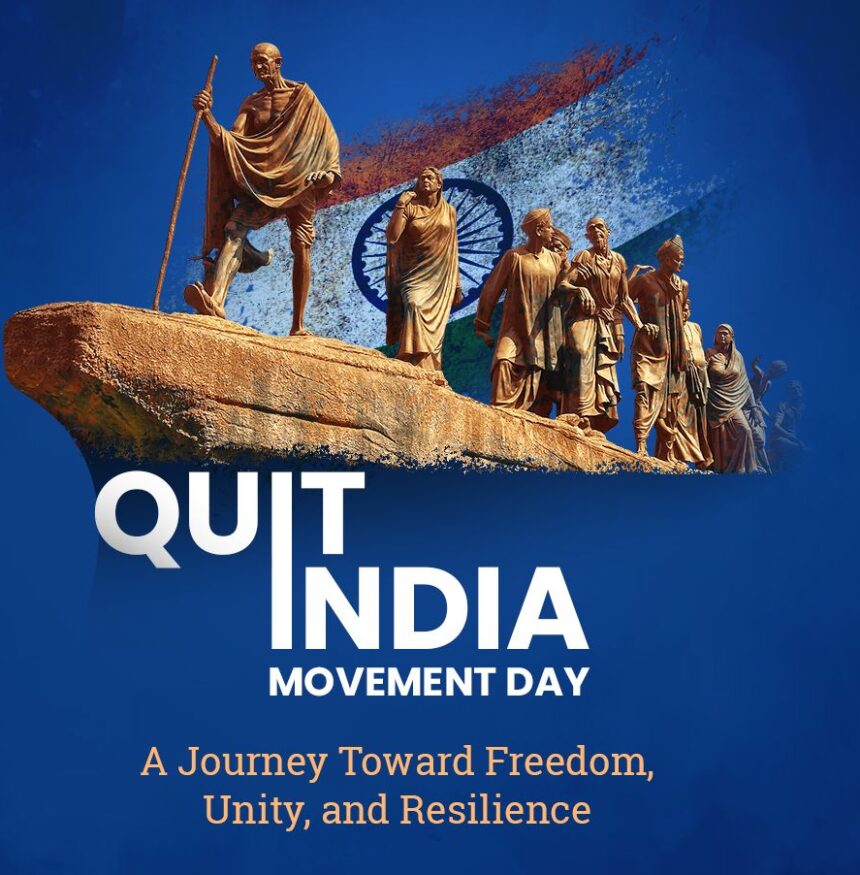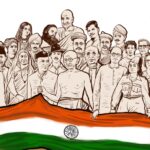🇮🇳 5 Bold Lessons from Quit India Movement Day That Still Shake the Nation
The echoes of “Do or Die” still ring in the heart of every Indian who understands the sacrifices made for our independence. Quit India Movement Day, observed every year on August 8, is a powerful reminder of the courage, unity, and urgency that fueled the final push against British colonialism.
- 🧭 History of Quit India Movement Day
- 🕰️ Timeline of Key Events
- 📊 Eye-Opening Facts About Quit India Movement
- 🌍 Significance of Quit India Movement Day
- 🛡️ Ultimate Test of Resolve
- 🧭 Turning Point in Freedom Struggle
- 🤝 Mass Involvement
- 🧘 Gandhi’s Non-Violence vs. People’s Fury
- 🧬 Spiritual Awakening
- 🎉 Observance & Commemoration
- 💌 Heartfelt Wishing Lines for Quit India Movement Day
- 🙋 Frequently Asked Questions (FAQs)
- Q1. What is the importance of Quit India Movement Day?
- Q2. Who launched the Quit India Movement?
- Q3. Why was the Quit India Movement violent in some areas?
- Q4. How long did the movement last?
- Q5. Did the British concede due to the movement?
- 💡 Important Points to Remember
- 💥 Importance in Our Life and Society Today
- 🧭 Daily Life Impacts
- 🏁 Conclusion: Remember, Reflect, and Rise
This article offers an inspiring, human-centered exploration of the history, facts, timeline, FAQs, significance, and societal impact of this pivotal day in Indian history. With over 1200 words, this is more than just a read—it’s a respectful remembrance of the soul of India’s freedom.
🧭 History of Quit India Movement Day
The Quit India Movement, also known as the August Movement or Bharat Chhodo Andolan, was launched by Mahatma Gandhi on August 8, 1942, at the All India Congress Committee (AICC) session held at Gowalia Tank Maidan in Bombay (now Mumbai).
🕊️ The Clarion Call: “Do or Die”
Gandhi gave the historic call for mass civil disobedience against British rule with the iconic slogan “Karenge ya Marenge” (Do or Die). The goal was simple yet profound: Britishers, Quit India.
🛑 Immediate Repression
The British arrested all major Congress leaders including Gandhi, Nehru, Sardar Patel, and Maulana Azad within 24 hours. Despite the leadership being jailed, the movement spread spontaneously across India—led by students, workers, farmers, and even women.
🕰️ Timeline of Key Events
| Date | Event |
|---|---|
| August 8, 1942 | Gandhi gives the “Quit India” speech in Mumbai |
| August 9, 1942 | Top Congress leaders arrested overnight |
| August 10–15, 1942 | Protests erupt across India: railways, post offices attacked |
| September 1942 | British respond with mass detentions, killings, and censorship |
| 1943 | Subhash Chandra Bose’s INA rises as parallel resistance |
| 1945 | British realize sustaining control is unfeasible post-World War II |
| August 15, 1947 | India achieves independence within 5 years of the movement |
📊 Eye-Opening Facts About Quit India Movement
Over 100,000 people were arrested, and thousands died or were injured.
The movement was entirely non-violent in Gandhi’s call, but turned violent in many areas due to public outrage.
Women like Aruna Asaf Ali and Usha Mehta played a major role, including in underground radio operations.
No major Congress leader was free during the bulk of the movement.
The British used extreme censorship and military force to suppress it.
Azad Hind Fauj (INA) under Subhash Chandra Bose gained momentum during this time.
Despite the setback, the movement unified the nation more strongly than ever before.
🌍 Significance of Quit India Movement Day
🛡️ Ultimate Test of Resolve
The movement was a defining moment where Indians displayed collective courage, risking life and liberty.
🧭 Turning Point in Freedom Struggle
While the movement was crushed violently, it became the final nail in the coffin for British imperialism in India.
🤝 Mass Involvement
Unlike earlier movements limited to elites, this movement saw participation from farmers, women, students, and youth.
🧘 Gandhi’s Non-Violence vs. People’s Fury
It showed the tension between Gandhian ideals and the masses’ frustration, highlighting evolving modes of resistance.
🧬 Spiritual Awakening
More than a political act, it was an awakening of national identity—a call to self-rule not just politically but morally.
🎉 Observance & Commemoration
Schools, colleges, and institutions hold debates, plays, and patriotic events.
Government and civic bodies honor freedom fighters and unsung heroes.
Documentaries and exhibits recount the journey of the movement.
Youth are encouraged to revisit speeches, letters, and writings from the era.
In recent years, digital campaigns like #QuitIndiaSpirit trend to reignite interest.
💌 Heartfelt Wishing Lines for Quit India Movement Day
“Let’s remember the courage that made us free. Happy Quit India Movement Day!”
“Salute to those who dared to dream of an independent India. Jai Hind!”
“Do or Die wasn’t just a slogan—it was a life commitment. Let’s honor it.”
“We owe our breath of freedom to their last breath of courage. Respect forever.”
🙋 Frequently Asked Questions (FAQs)
Q1. What is the importance of Quit India Movement Day?
It commemorates the most decisive mass movement in India’s freedom struggle and reminds us of the power of united action.
Q2. Who launched the Quit India Movement?
Mahatma Gandhi, at the Bombay session of the All India Congress Committee on August 8, 1942.
Q3. Why was the Quit India Movement violent in some areas?
Although Gandhi called for non-violence, public frustration and lack of leadership due to arrests led to spontaneous acts of sabotage and rebellion.
Q4. How long did the movement last?
The most intense phase lasted from August to December 1942, though resistance continued through 1945.
Q5. Did the British concede due to the movement?
While the movement was suppressed, it made it clear that India was ungovernable without consent, speeding up British withdrawal.
💡 Important Points to Remember
Gandhi’s “Do or Die” was not just for war, but for dignified self-rule.
Women and youth were pillars of the underground resistance.
Despite arrests, the spirit of the nation did not break.
The day teaches us the value of unity, non-violence, and civic courage.
Legacy lives on through every act of democratic dissent in modern India.
💥 Importance in Our Life and Society Today
🧑⚖️ Civic Responsibility
It reminds citizens of the power and responsibility they hold to speak against injustice and shape democracy.
🏫 Education
The movement is a lesson in moral courage, leadership, and history for students and young leaders.
🏛️ Political Inspiration
Today’s lawmakers and reformers draw ideological strength from this mass uprising.
🧑🤝🧑 Social Unity
The Quit India Movement united people across caste, religion, and region—a model for inclusive activism today.
🌏 Global Influence
The movement’s principles influenced anti-colonial struggles in other parts of Asia and Africa.
🧭 Daily Life Impacts
Freedom to express dissent peacefully is a right earned by this movement.
Civic activism owes its legacy to the courage shown in 1942.
National holidays and symbols (like the flag) draw emotional strength from this struggle.
Voting rights, democracy, and self-governance exist due to sacrifices made during this time.
Modern protests often cite Gandhi’s strategy as their foundation.
🏁 Conclusion: Remember, Reflect, and Rise
Quit India Movement Day is not just about remembering history—it’s about owning it. The freedom we enjoy was born not just from battles, but from the bravery of ordinary people who believed in something greater than themselves.
As citizens of a free nation, our duty is to preserve this freedom, guard our democracy, and act with the same courage when the nation needs us. Their sacrifices demand more than remembrance—they demand continuity of purpose.
🇮🇳 “Let’s not just celebrate freedom—let’s honor the price paid for it.”
Happy Quit India Movement Day! Jai Hind!









Unquestionably believe that which you stated. Your favorite reason appeared to be on the net the easiest thing to be aware of. I say to you, I definitely get annoyed while people consider worries that they just do not know about. You managed to hit the nail upon the top and also defined out the whole thing without having side effect , people could take a signal. Will likely be back to get more. Thanks